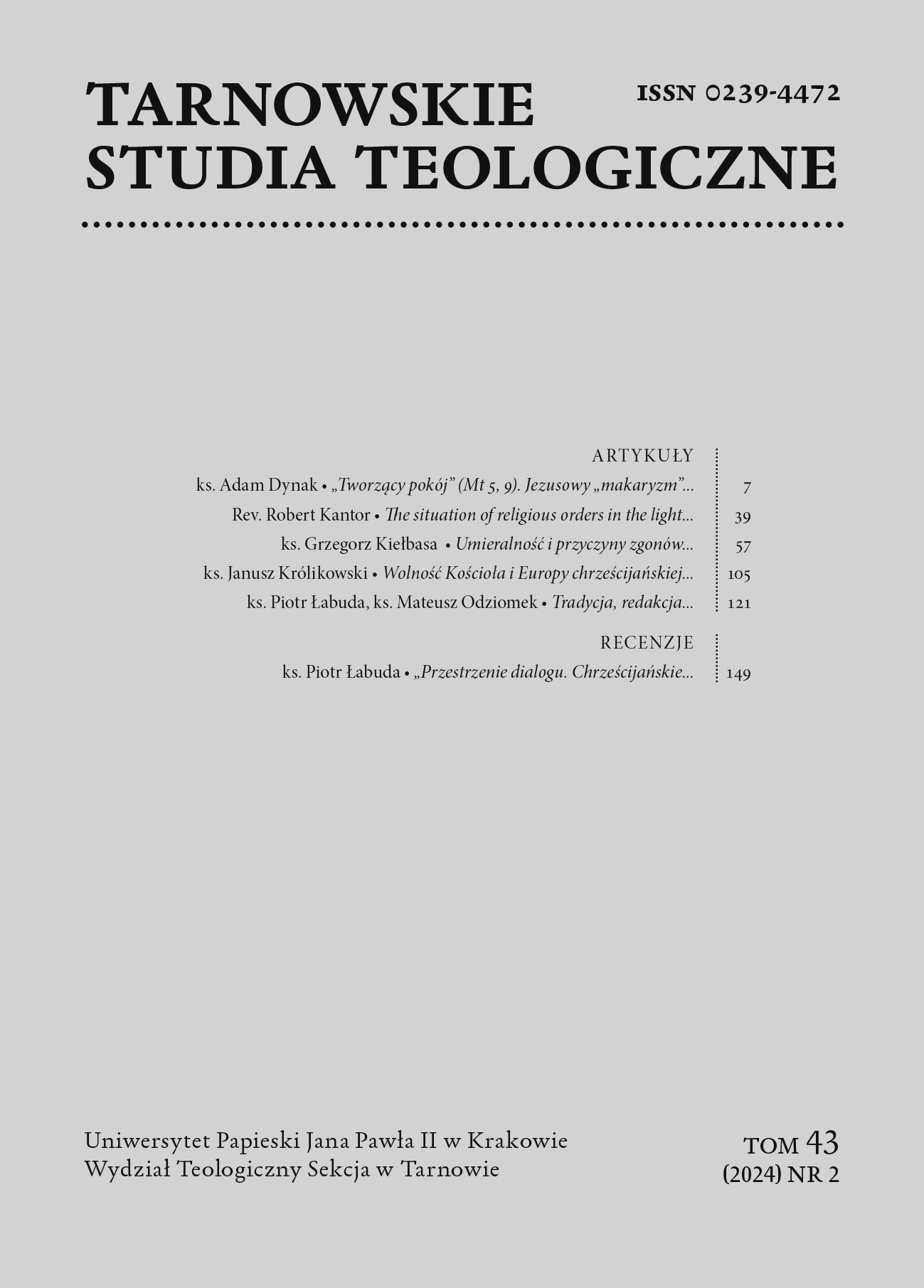The situation of religious orders in the light of the 1917 Code of Canon Law
DOI:
https://doi.org/10.15633/tst.43202Keywords:
Code of Canon Law 1917, duties of religious, ecclesiastical superiors, religious ordersAbstract
The Code of Canon Law of 1917 was dedicated to the matters related to religious orders in Book II, part II, canons: 487–681. An important issue is providing the definition of the religious state by the ecclesiastical legislator. The Code defines it as a stable manner of living in common approved by the Church, by which the faithful, want not only to keep the commandments common to all, but they also want, through a public vow, to strive for perfection by following the evangelical counsels of obedience, chastity and poverty and by living in common and observing the statutes under a legitimate superior. This paper addresses the key issues of the life of religious, regulated by the law contained in the 1917 Code. Therefore, there will be a discussion of religious’ superiors, candidates for a religious order, obligations of religious, and finally, of issues related to leaving and dismissal from a religious order.
References
Bar J. R., O zakonach i osobach świeckich, Warszawa 1968.
Bar J. R., Prawo zakonne po soborze watykańskim II, Warszawa 1971.
Bastien P., Directoire canonique, Bruges 1933.
Battandier A., Guide canonique pour les constitutions des Instituts a voeux simples, Paris 1923.
Bączkowicz F., Baron J., Stawinoga W., Prawo kanoniczne. Podręcznik dla duchowieństwa, vol. 1, Opole 1957.
Bogdan F., Prawo Instytutów Życia Konsekrowanego. Nowe prawo zakonne, Poznań–Warszawa 1977.
Bogdan F., Przegląd piśmiennictwa z dziedziny prawa zakonnego, „Roczniki Teologiczno-Kanoniczne” 6 (1960) z. 3, p. 99–134.
Chelodi Joannes, Ius de personis, Tridenti 1922.
Codex Iuris Canonici Pii X Pontificis Maximi iussu digestus Benedicti Papae XV auctoroitate promulgates praefatione fontium annotatione et indice analytico-alphabetico ab emo Petro card. Gaspari auctus, Typis Polyglottis Vaticanis 1918.
Dudziak J., Wprowadzenie do nauki prawa kanonicznego. Pomoc akademicka dla studentów teologii, Tarnów 1999.
Fanfani L. G., De iure religiosorum, Taurini–Romae 1925.
Góralski W., „Salus animarum suprema lex”. W 25. rocznicę promulgowania przez Jana Pawła II Kodeksu Prawa Kanonicznego, „Studia Płockie” 36 (2008), p. 253–264.
Kałowski J., Skutki prawne opuszczenia instytutu zakonnego, „Prawo kanoniczne” 32 (1989) nr 3–4, p. 21–59, https://doi.org/10.21697/pk.1989.32.3-4.02.
Pontifficia Commissione Interpratativa, 30.07.1934, „Acta Apostolicae Sedis” 26 (1934), p. 494.
Sobradillo A., Tractatus de religiosarum confessariis, Torino 1931.
Szewczul B., Od reguł monastycznych do konstytucji zakonnych, „Prawo Kanoniczne” 60 (2017) nr 1, p. 35–71, https://doi.org/10.21697/pk.2017.60.1.03.
Wernz F. X., Vidal P., Ius canonicum ad Codicis normam exactum opera Petri Vidal, vol. 3: De religiosis, Romae 1933.
Downloads
Published
Issue
Section
License
Copyright (c) 2024 Robert Kantor

This work is licensed under a Creative Commons Attribution 4.0 International License.
Authors who publish with this journal agree to the following terms:
- Authors retain the copyright and full publishing rights without restrictions, and grant the journal right of first publication with the work simultaneously licensed under a Creative Commons Attribution 4.0 International License that allows others to share the work with an acknowledgement of the work's authorship and initial publication in this journal.
- Authors are able to enter into separate, additional contractual arrangements for the non-exclusive distribution of the journal's published version of the work (e.g., post it to an institutional repository or publish it in a book), with an acknowledgement of its initial publication in this journal.
- Authors are permitted and encouraged to post their work online (e.g., in institutional repositories or on their website) prior to and during the submission process, as it can lead to productive exchanges, as well as earlier and greater citation of published work (See The Effect of Open Access).

